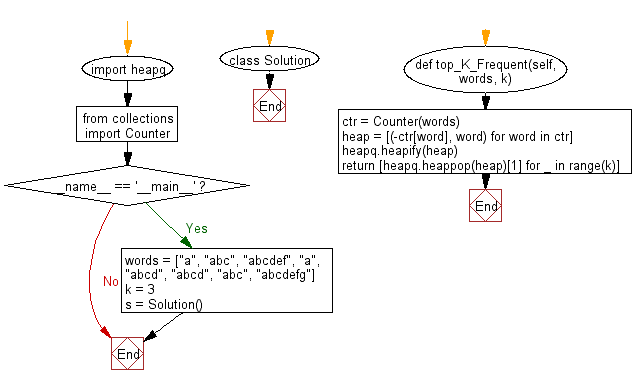Python: Get the k most frequent elements from a given non-empty list of words using Heap queue algorithm
Python heap queue algorithm: Exercise-14 with Solution
Write a Python program to get the k most frequent elements from a given non-empty list of words using Heap queue algorithm.
Note:
Range of k, 1 ≤ k ≤ number of unique elements and input words contain only lowercase letters.
Sample Solution:
Python Code:
import heapq
from collections import Counter
class Solution:
def top_K_Frequent(self, words, k):
"""
:type words: List[str]
:type k: int
:return type: List[str]
"""
ctr = Counter(words)
heap = [(-ctr[word], word) for word in ctr]
heapq.heapify(heap)
return [heapq.heappop(heap)[1] for _ in range(k)]
if __name__ == '__main__':
words = ["a", "abc", "abcdef", "a", "abcd", "abcd", "abc", "abcdefg"]
k = 3
s = Solution()
print("3 most frequent elements:")
print(s.top_K_Frequent(words, k))
Sample Output:
3 most frequent elements: ['a', 'abc', 'abcd']
Flowchart:

Visualize Python code execution:
The following tool visualize what the computer is doing step-by-step as it executes the said program:
Python Code Editor:
Have another way to solve this solution? Contribute your code (and comments) through Disqus.
Previous: Write a Python program to find the nth super ugly number from a given prime list of size k using Heap queue algorithm.
Next: Write a Python program to check if the letters of a given string can be rearranged so that two characters that are adjacent to each other are different using Heap queue algorithm.
What is the difficulty level of this exercise?
Test your Programming skills with w3resource's quiz.
Python: Tips of the Day
Find current directory and file's directory:
To get the full path to the directory a Python file is contained in, write this in that file:
import os dir_path = os.path.dirname(os.path.realpath(__file__))
(Note that the incantation above won't work if you've already used os.chdir() to change your current working directory, since the value of the __file__ constant is relative to the current working directory and is not changed by an os.chdir() call.)
To get the current working directory use
import os cwd = os.getcwd()
Documentation references for the modules, constants and functions used above:
- The os and os.path modules.
- The __file__ constant
- os.path.realpath(path) (returns "the canonical path of the specified filename, eliminating any symbolic links encountered in the path")
- os.path.dirname(path) (returns "the directory name of pathname path")
- os.getcwd() (returns "a string representing the current working directory")
- os.chdir(path) ("change the current working directory to path")
Ref: https://bit.ly/3fy0R6m
- New Content published on w3resource:
- HTML-CSS Practical: Exercises, Practice, Solution
- Java Regular Expression: Exercises, Practice, Solution
- Scala Programming Exercises, Practice, Solution
- Python Itertools exercises
- Python Numpy exercises
- Python GeoPy Package exercises
- Python Pandas exercises
- Python nltk exercises
- Python BeautifulSoup exercises
- Form Template
- Composer - PHP Package Manager
- PHPUnit - PHP Testing
- Laravel - PHP Framework
- Angular - JavaScript Framework
- Vue - JavaScript Framework
- Jest - JavaScript Testing Framework
